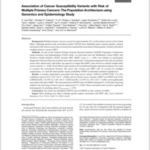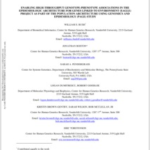Multiple primary cancers account for approximately 16% of all incident cancers in the United States. Although genome-wide association studies (GWAS) have identified many common genetic variants associated with various cancer sites, no study has examined the association of these genetic variants with risk of multiple primary cancers (MPC).As part of the National Human Genome Research […]
Tag Archives: Neoplasms
Association of cancer susceptibility variants with risk of multiple primary cancers: The population architecture using genomics and epidemiology study.
Park SL, Caberto CP, Lin Y, Goodloe RJ, Dumitrescu L, Love SA, Matise TC, Hindorff LA, Fowke JH, Schumacher FR, Beebe-Dimmer J, Chen C, Hou L, Thomas F, Deelman E, Han Y, Peters U, North KE, Heiss G, Crawford DC, Haiman CA, Wilkens LR, Bush WS, Kooperberg C, Cheng I, Le Marchand L,. Multiple primary […]
Enabling high-throughput genotype-phenotype associations in the Epidemiologic Architecture for Genes Linked to Environment (EAGLE) project as part of the Population Architecture using Genomics and Epidemiology (PAGE) study.
Genetic association studies have rapidly become a major tool for identifying the genetic basis of common human diseases. The advent of cost-effective genotyping coupled with large collections of samples linked to clinical outcomes and quantitative traits now make it possible to systematically characterize genotype-phenotype relationships in diverse populations and extensive datasets. To capitalize on these […]
Enabling high-throughput genotype-phenotype associations in the Epidemiologic Architecture for Genes Linked to Environment (EAGLE) project as part of the Population Architecture using Genomics and Epidemiology (PAGE) study.
Bush WS, Boston J, Pendergrass SA, Dumitrescu L, Goodloe R, Brown-Gentry K, Wilson S, McClellan B, Torstenson E, Basford MA, Spencer KL, Ritchie MD, Crawford DC,. Genetic association studies have rapidly become a major tool for identifying the genetic basis of common human diseases. The advent of cost-effective genotyping coupled with large collections of samples […]




